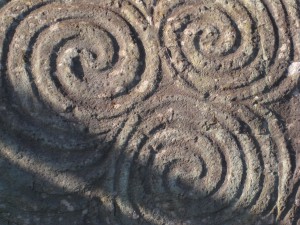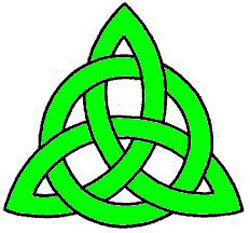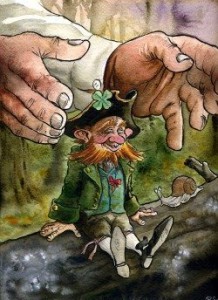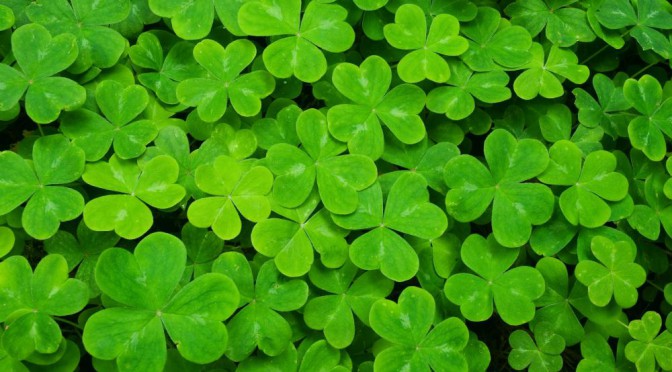As of this writing, St. Patrick’s Day is once again on the horizon. A festive but rarely understood holiday, St. Patrick’s Day is a colorful combination of the Catholic faith, Celtic traditions, and American love for an excuse to drink. Truly the child of multiculturalism, the American version of St. Patty’s is generally full of traditions no one understands but will eagerly follow regardless.
Most people have no idea who St. Patrick actually was aside from a story where he drove the snakes out of Ireland (an island which never had a native snake population in the first place). No one’s particularly sure why they have to wear green, or why you’re required to pinch someone who doesn’t. Very few people who follow it have any idea what the actual Catholic traditions are for the day. And other elements are just generally a complete mystery.
For instance: why the hell are shamrocks and their four leaf cousins lucky? And, for that matter, why would they represent the…
“Luck Of The Irish”

Next to Guinness and Leprechauns, when someone thinks of Ireland they likely picture a shamrock. A symbol of the country for so long that it was even included on the UK’s money for a time, the shamrock or three leaf clover is probably one of the most recognizable emblems of the Irish, Ireland, and particularly St. Patrick’s day. Legend even has it that the reason for this is because St. Patrick used the little leafy plant to explain the holy trinity of the Catholic faith. It only makes sense that this symbol would be associated with the day then, right?
But, one would have to ask, why are they also considered lucky?
Some can, and do, argue today that the shamrock is actually a symbol of holy power. This doesn’t just root back to Patrick, who used it during the conversion of Ireland and the “chasing of the snakes”. According to some sources, as she walked out of the Garden of Eden after her unfortunate fruit incident, Eve was carrying the first shamrock. If you believe this, then the shamrocks are essentially remnants of paradise and are still untainted by the world of man after all this time.

But when looking at it deeper you realize that Christianity wasn’t the source of the plant being considered a charm. Rather, when St. Patrick picked it up, he knew he was picking up something that was already important to the people he was dealing with. Going as far back as the Celtic Druids, the shamrock and its four leafed cousin have been used as mystical wards and symbols important to their religion even back to the time before written history.
The old Celtic traditions held that someone carrying a shamrock would be able to ward away evil. Though it’s worth noting that, unlike most wards, the shamrock wouldn’t drive the evil away but rather slow them down just long enough to let the holder run away. Still, for what it was worth, it managed to work. The reasons for this power vary from source to source but almost always seem to be rooted in the symbolism.

The Celtic faith saw a great value in the power of threes. Throughout ancient Celtic artwork and monuments you can find symbols such as the triple knot and triple spiral. They even had deities which consisted of three entities bound together to act as a single whole. So to the Celtic people, the image of three leaves coming together at a single point was a perfect representation in nature of something they already believed. It would be like a Christian finding a flower that formed a perfect cross.

Because of this, the Celtic people believed that the shamrock was connected to the world beyond and that it could interact with that world easier than they could. It was supposed to slow evil, deter fairies, and even deflect bad luck. This last element was partially because there were few incidents that the Celts saw as simply random chance. No bad luck was just a random event but rather the acts of an unseen fairy which was working against them. So when St. Patrick used the plant for his own teachings, he was weaving in things they already believed such as a connection to the world beyond and the idea that something really was working against them.

But as for the four leaf variety, that’s considered lucky entirely due to the rarity. Though often referenced, the four leaf clover is an incredibly rare deformation of the three leaf variety. No clover plant in the world naturally creates four leaves, so the chances of finding a four leafed clover is something to the tune of 10,000 to 1. Because of this, it was believed by the Celts and many others that the four leaf variety had something special to it that the others lacked. Some even describe this as each leaf representing a different virtue such as faith, hope, love, and luck. Because of this, the four leaf clover in ancient times was believed to be an even more powerful version of the shamrock with a greater connection to the spiritual world. Its extra leaf was essentially one step closer to the world beyond – to the point that it could do more than simply ward away the fairies, it could reveal them.
A common superstition is that anyone who holds a four leaf clover doesn’t just get protection from fairy magic but can even dispel some of it and reveal their location. Since invisible fairies were thought to be the origin of bad luck, a good luck charm with extra power should render them visible. Children in certain regions of the world will go to great lengths to first seek out a four leaf clover in a garden and then use that clover to turn around and hunt down a fairy hiding in the same space. Considering that many of these regions also hold that anyone who captures a member of the fairy folk will get a wish out of it – it’s easy to see why someone would want one.

And, because the plant is so common on their island, it’s also believed by some that Ireland is the place where the most four leaf clovers grow in the world. Of course, this probably isn’t true since any place that has sufficient numbers of clovers will eventually sprout four leafed varieties, but the reputation’s stuck throughout history. In fact, because of this association with clovers, many believe the Irish themselves to be lucky by proximity. The Irish have never really discouraged this notion since, with the plant being so closely tied to their ancient and modern beliefs, they’ve been bound to it for almost as long as civilization. As the rose represents England and the thistle represents Scotland, the clover has just always represented Ireland.
So, as you partake of the American version of other Irish traditions…
Try to have a clover handy. You never know when the wee folk might strike.
(I write novels and I’m dabbling in screenplays. You can find me on twitter and possibly wandering the streets slurring my words on St. Patrick’s Day. Not that I drink, it’s just spring and I take a lot of allergy meds.)







